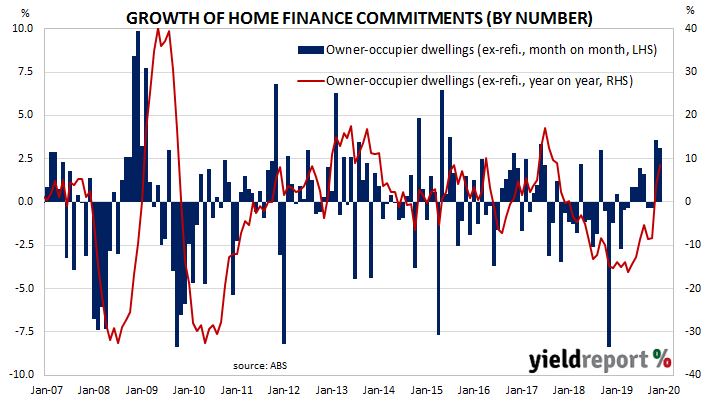A very clear downtrend was evident in the monthly figures of both the number and value of home loan commitments through late-2017 to mid-2019. Then the RBA began to reduce its cash rate target in a series of cuts and both the number and value of mortgage approvals began to noticeably increase.
January’s housing finance commitment figures have now been released and the total number of loan commitments (excluding refinancing loans) to owner-occupiers increased by 3.1%, a slight slowing on December’s revised figure of +3.6%. On an annual basis, the growth rate accelerated from December’s revised figure of +3.9% to +8.4%.
Westpac senior economist Matthew Hassan said the number of approvals for construction-related projects suggests a turnaround had begun. “Overall, the picture continues to point to a clear turning point in non-high-rise building activity. The lift in purchases of newly-built dwellings will also help high-rise developers clear unsold stock but is less likely to drive a lift in new projects.”
 Local Treasury bond yields finished considerably lower, ignoring unusually large increases in US yields in overnight trading. By the end of the day, the 3-year ACGB yield had lost 9bps to 0.39%, the 10-year yield had fallen by 12bps to 0.67% while the 20-year yield finished just 5bps lower at 1.14%.
Local Treasury bond yields finished considerably lower, ignoring unusually large increases in US yields in overnight trading. By the end of the day, the 3-year ACGB yield had lost 9bps to 0.39%, the 10-year yield had fallen by 12bps to 0.67% while the 20-year yield finished just 5bps lower at 1.14%.
Prices of cash futures contracts moved to reflect a slight firming of rate-cut expectations but only in a theoretical sense. The April contract still implied a 25bps cut to be fully factored in, the same as at the end of the previous day’s trade. Further rate cuts were seen as not particularly likely as the cash rate target would already be at what the RBA considers to be the effective lower bound of 0.25%.

